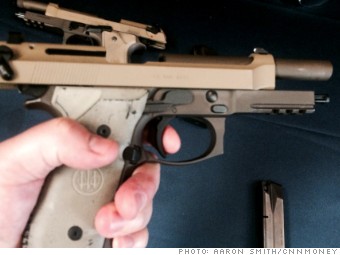

M9 Sights are dot and post and 92 are 3-dot, finish may be a little nicer on 92, recoil spring guide used to be a little different on 92 but think they are the same now. The reason is that it was designed-and has kept evolving-to be and remain the most accurate, durable and reliable semiauto handgun on the market. The Beretta 92FS has been setting the standards for best military, police and tactical pistol for over a quarter century. So you get the slanted dust cover on th ecurrent 92FS's because it's cheaper to make frames all the same. Only very small differences between M9/92FS. 92FS: The World’s Most Trusted Military and Police Pistol. When I bought this gun, it came with a couple of weedy magazines. Since commercial frames share the same production line regardless of caliber, Beretta uses the same configuration on both 9mm and. The 92FS, or in this case a gun that’s stamped M9, is still a rock star. I regularly carried a 92 for yearsright up until I bought a Sig P226.

In addition, GAO found that the Army cancelled the on-going competition for follow-on procurement of 9-mm handguns, began a new competition in May 1988, and expected to award the contract in 1989. As far as handling goes, the Beretta 92FS is easy to control. GAO also found that a February 1988 Army report concluded that current M9 met the 1984 requirements and that contract changes have not materially altered their characteristics or configuration or degraded their performance.

GAO also found that: (1) M9 had 14 slide failures, causing injuries to four shooters (2) the contractor believes that the failures resulted from firing incorrect ammunition, but the Army believes that metal fatigue is the primary cause of failure (3) there was no evidence that the Army attempted to cover up the problem, as it issued a safety message to all M9 users shortly after the first slide failure and (4) the Army plans to stop delivery of M9 until the contractor corrects the problem. GAO found that: (1) the Army contracted to buy 321,260 M9 valued at $77.3 million (2) as of August 17, 1988, the Army accepted delivery of 133,830 M9 and (3) M9 have experienced frame cracks, causing the Army to reject about 12,000 and the contractor to implement an engineering change proposal in April 1988 to correct the problem. It’s no surprise why the military wanted a polymer firearm besides for being cheaper to make, polymers tend to handle environmental abuse better.
DIFFERENCE BETWEEN BERETTA M9 AND 92FS UPDATE
This key update drops the excess weight that its heavy predecessor, the Beretta M9, could not. GAO discussed the military's M9 9-millimeter (mm) handguns, focusing on: (1) M9 safety and quality problems (2) allegations that the Army attempted to cover up the problems (3) similarities and differences between M9 tested in 1984 and current M9 and (4) the status of recompetition for award of a follow-on procurement contract. One of the biggest differences, or upgrades if you will, is that the M17 is polymer-framed.


 0 kommentar(er)
0 kommentar(er)
